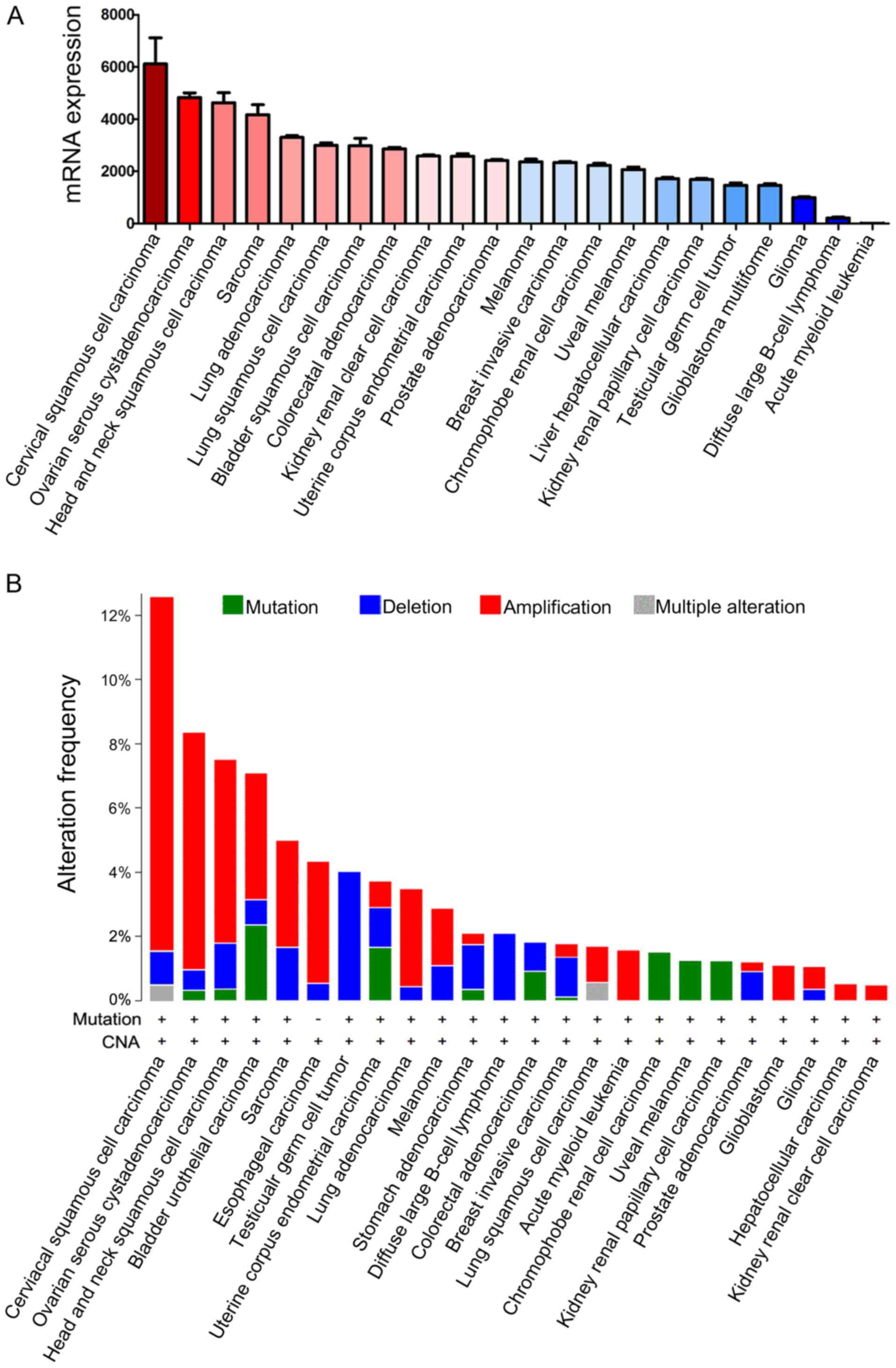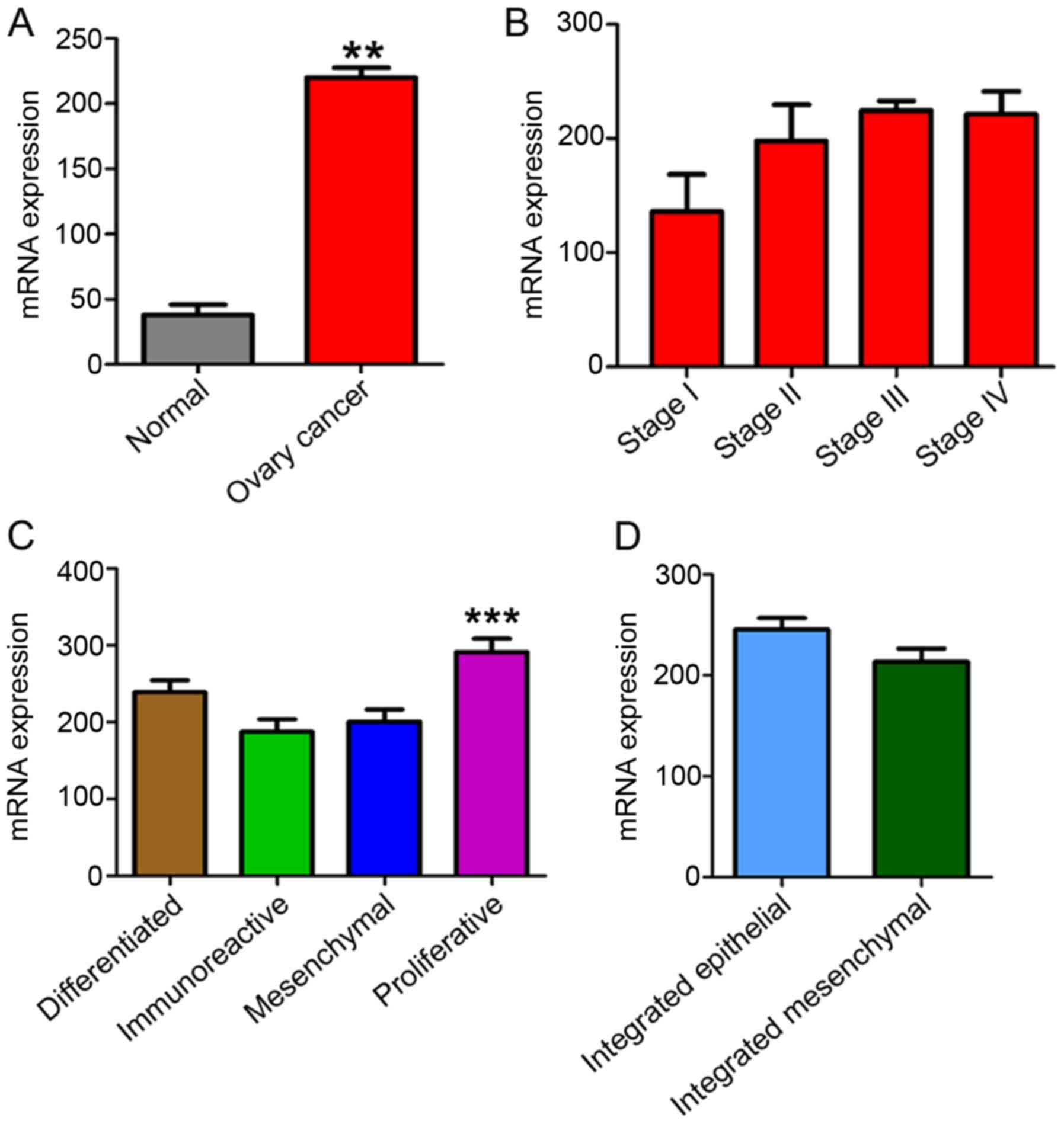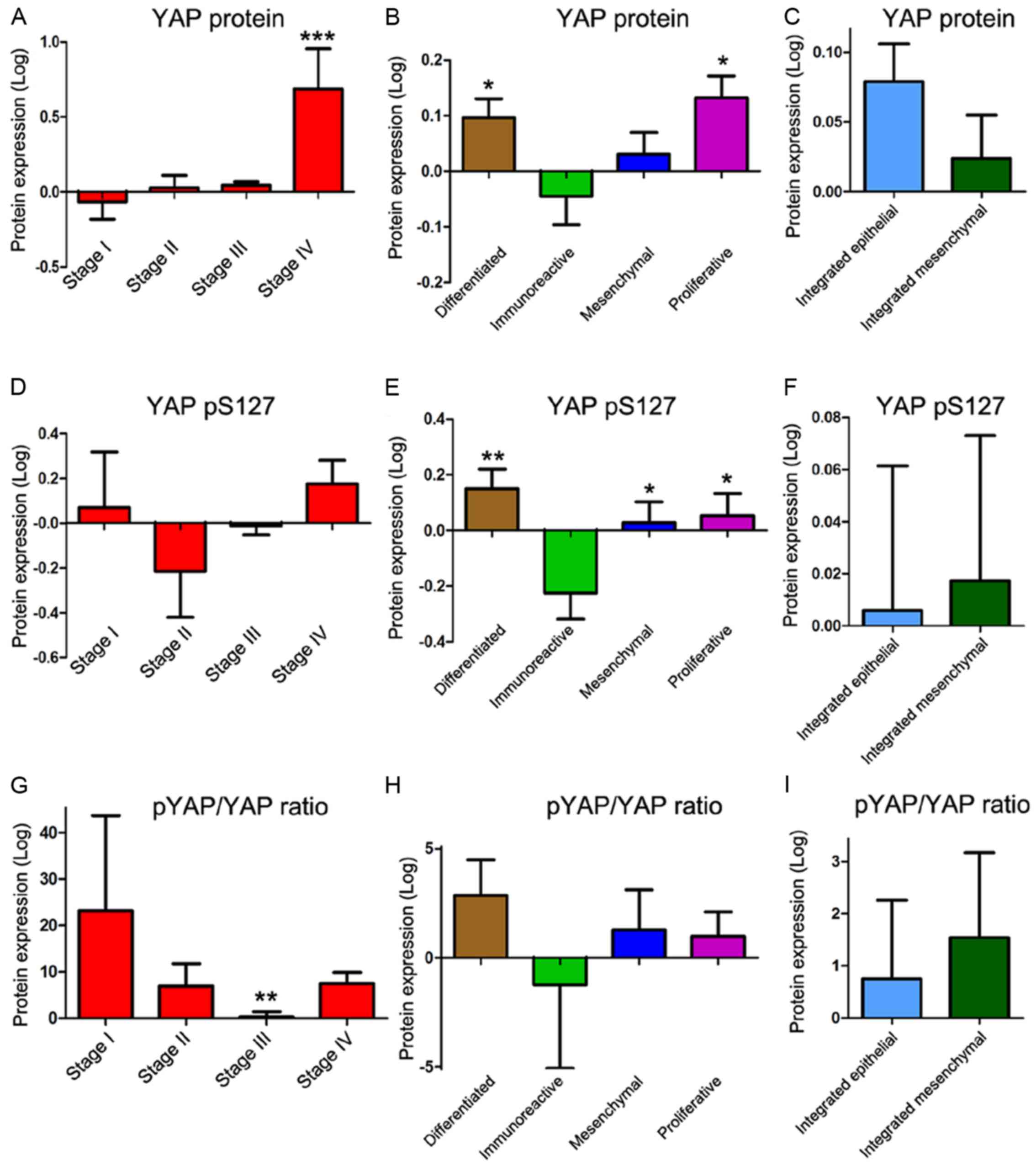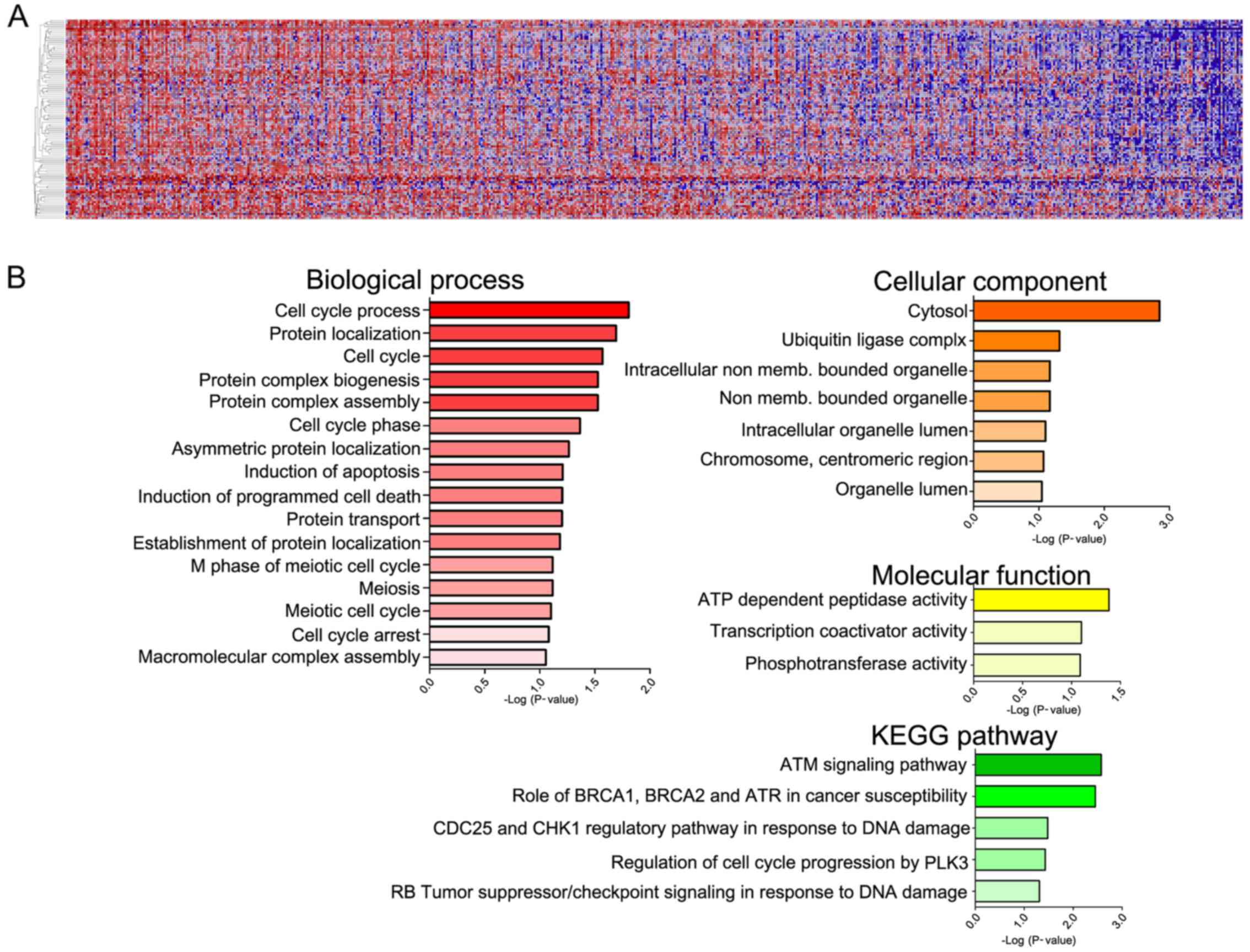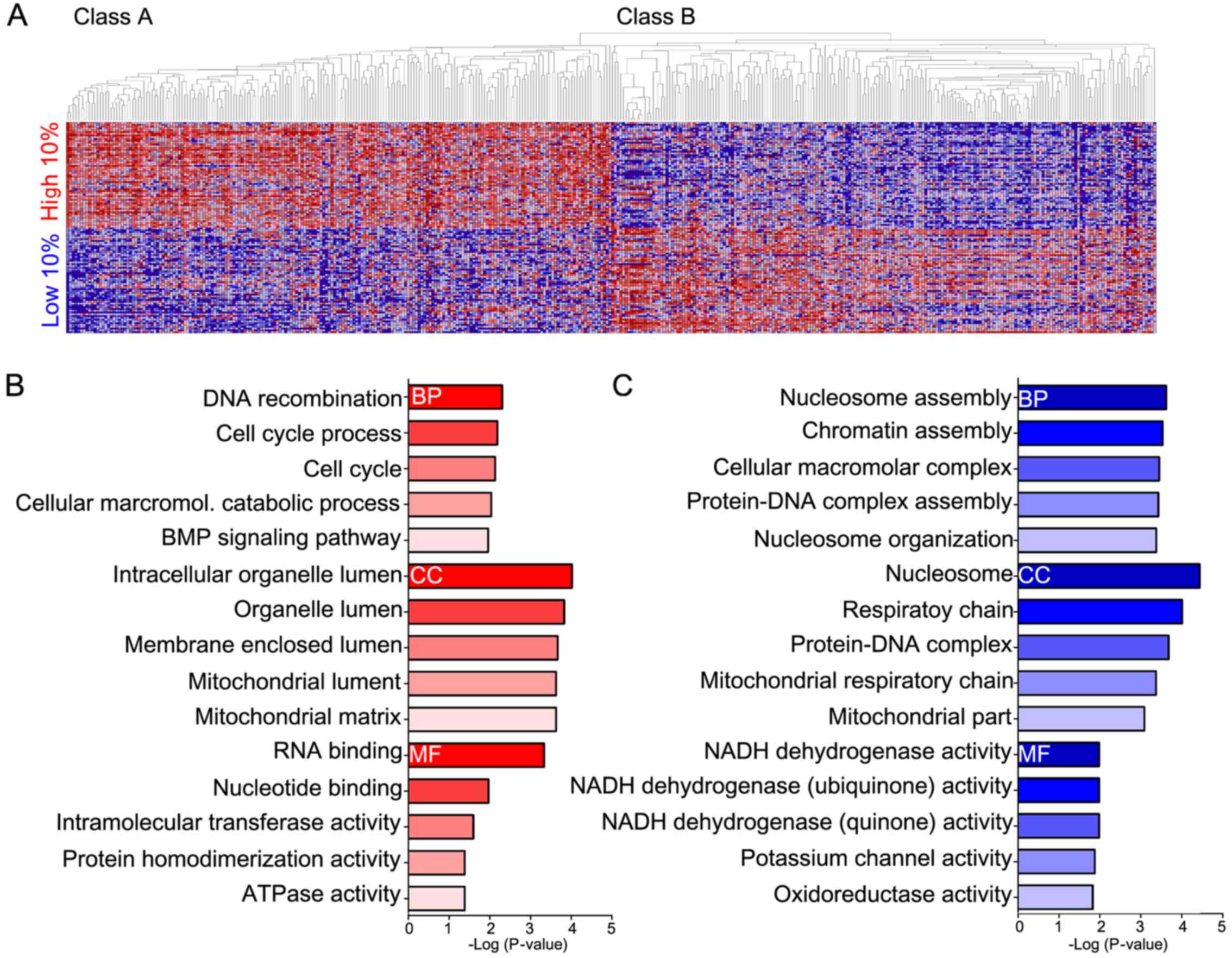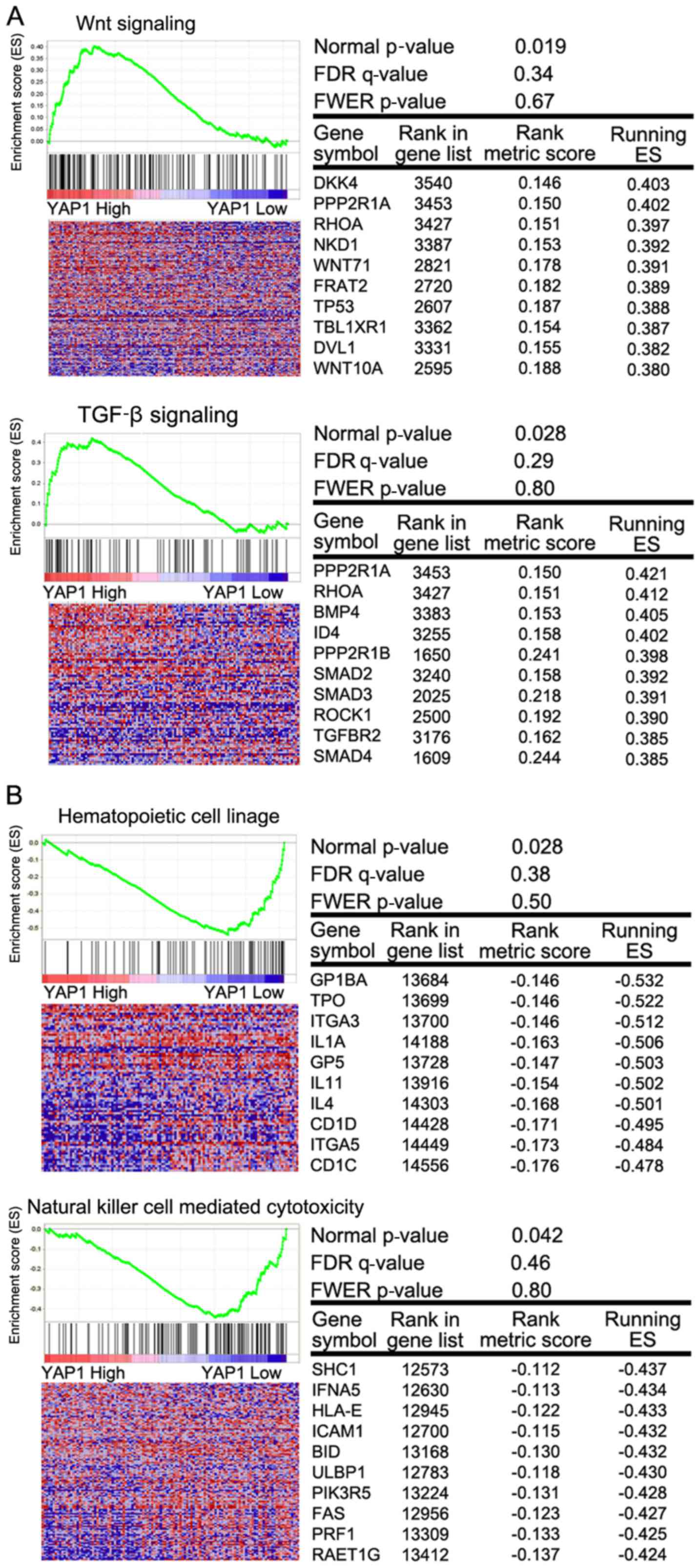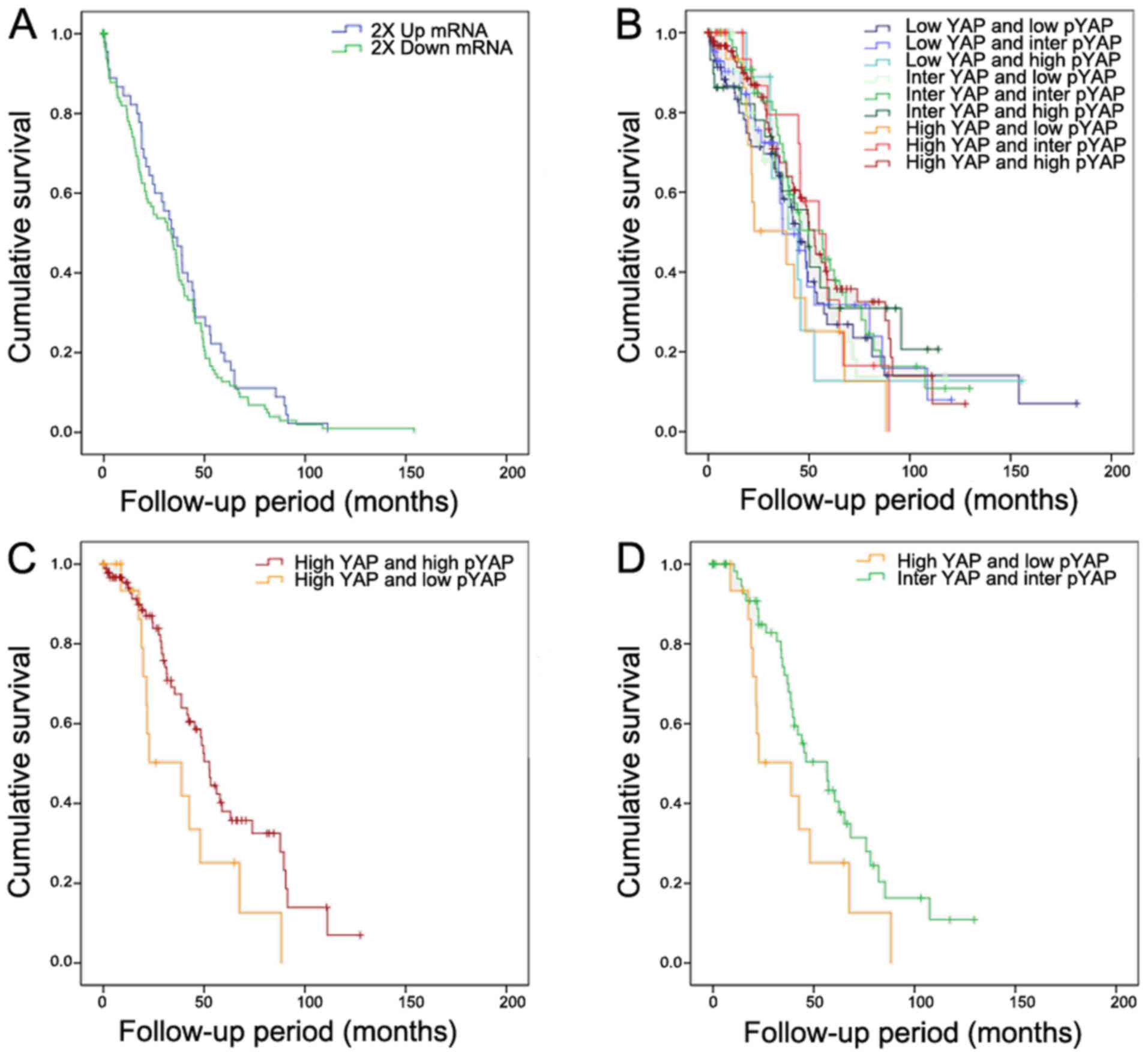Expression of Yes-associated protein 1 and its clinical significance in ovarian serous cystadenocarcinoma
- Authors:
- Published online on: March 21, 2017 https://doi.org/10.3892/or.2017.5517
- Pages: 2620-2632
-
Copyright: © Cho et al. This is an open access article distributed under the terms of Creative Commons Attribution License.
Abstract
Introduction
Yes-associated protein (YAP), along with the transcriptional co-activator TAZ, is a main downstream effector of the Hippo pathway, which regulates tissue homeostasis, organ size, regeneration and tumorigenesis (1). In mammalian systems, the Hippo pathway is composed of the core kinase complexes mammalian Ste2-like kinases 1/2 and large tumor suppressor kinases 1/2 (2). The main function of the Hippo pathway is to negatively regulate the activity of YAP and TAZ, to promote cellular proliferation, and to induce anti-apoptotic genes via interactions with various transcription factors (2–4). When the Hippo pathway is active, the inhibitory mammalian Ste2-like kinases/large tumor suppressor kinases phosphorylate YAP and TAZ. Phosphorylation leads to nuclear exclusion of YAP and TAZ. Then, YAP and TAZ are sequestered and subjected to proteasomal degradation in the cytoplasm; also, gene expression of YAP- and TAZ-driven molecules is suppressed (4,5).
Overexpression of YAP1 has been found in various types of cancers (6–9), and may lead to oncogenic transformation of immortalized epithelial cells (10). The expression and role of YAP1 in cancer is cell type-dependent (11,12). Overexpression of YAP was observed in 62% of hepatocellular carcinomas and 72.6% of colorectal cancers, and was found to be an independent predictor associated with poor disease-free survival and overall survival (13). In 66.3% of non-small cell lung cancers, YAP was found to be overexpressed, and was associated with reduced overall survival (14). Several studies reported that YAP1 is overexpressed in ovarian cancer (6) and acts as an oncogene (15). Zhang et al reported that high levels of nuclear YAP1 correlate with poor prognosis in ovarian cancer patients with clear cell carcinoma (15). Another study showed that YAP1 is highly expressed in serous/endometrioid cystadenocarcinomas, and is positively associated with patient prognosis (16). However, the role of YAP1 as an oncogene has not yet been fully investigated in a large group of ovarian serous cystadenocarcinoma (OSC) patients, who account for the largest proportion of malignant ovarian cancer cases (17,18). Therefore, in the present study, we investigated the expression of YAP1 and determined its clinical significance in OSC.
Materials and methods
Gene expression profiles
Level 3 mRNA expression data from 8 normal and 590 OSC samples were obtained from the TCGA data portal (https://tcga-data.nci.nih.gov/tcga/).
Analysis of mRNA microarray data
The raw data was initially analyzed using R software (v.3.2.5; http://www.r-project.org/). The chip data was normalized using the RankNormalize module in GenePattern (http://www.broadinstitute.org/cancer/software/genepattern). GeneNeighbors and ClassNeighbors, modules programmed in GenePattern (http://www.broadinstitute.org/cancer/software/genepattern), were used to select genes closely related to YAP1 (19). cBioportal (http://www.cbioportal.org/) was also used to analyze cross-cancer alterations in YAP1.
Functional enrichment analysis
The DEGs were imported into the Database for Annotation, Visualization and Integrated Discovery (http://david.abcc.ncifcrf.gov/) (20) in order to perform Gene Ontology (GO) functional enrichment analysis. Gene set enrichment analysis (GSEA) was used to enrich the mRNAs predicted to have a correlation with pathway in C2, curated gene set enrichment analysis (21,22). GO analysis encompasses 3 domains: biological processes, cellular components and molecular functions. P<0.05 was considered to indicate statistical significance.
Statistical analysis
The distributions of characteristics between the 2 groups were compared using the t-test for continuous variables (or the Kolmogorov-Smirnov test when the expected frequency within any cell was <5), and the χ2 test (or Fisher's exact test when the expected frequency within any cell was <5) for categorical variables. The distributions of characteristics between 3 or more groups were compared using ANOVA. Cumulative event (death) rate was calculated by the Kaplan-Meier method, using the time to the first event as the outcome variable. Probability of and calculated risk for recurrence were determined by actuarial analysis. The criteria for statistical analysis were date of operation and date of death. Survival curves were compared by the log-rank test for various recurrence factors and Cox's model for multivariate analysis. A P-value of<0.05 was considered statistically significant. Statistical analyses were performed using the Prism 5.0 software (GraphPad Prism Software, La Jolla, CA, USA), and the Statistical Package for Social Sciences for Windows (SPSS, Inc., Chicago, IL, USA).
Results
Cross-cancer mRNA expression and alterations in the YAP1 gene
YAP1 mRNA expression in cases of OSC was higher than in 21 other cancer types recorded in the TCGA database. mRNA expression of YAP1 was lowest in acute myeloid leukemia (Fig. 1). Cross-cancer alteration was investigated in 21 types of cancer, and YAP1 expression in OSC was the greatest among the 21 types of cancers recorded in the TCGA.
YAP1 mRNA expression in OSC
The present study examined YAP1 mRNA expression in OSC compared with 8 normal control samples (Fig. 2). Clinicopathological information of the patients is shown in Table I. YAP1 mRNA expression was significantly higher in cases of OSC compared to normal controls (Fig. 2A). YAP1 mRNA expression was higher in stages III and IV compared to earlier stages (Fig. 2B). When comparing YAP1 mRNA expression in 4 subtypes of ovarian cancer, differentiated, immunoreactive, mesenchymal and proliferative, and in 2 subtypes of ovarian cancer, integrated mesenchymal and epithelial subtypes (23,24), YAP1 mRNA expression in the proliferative subtype was significantly higher than that in the differentiated, immunoreactive and mesenchymal subtypes (Fig. 2C). However, there was no significant difference in expression between the integrated mesenchymal subtype vs. the integrated epithelial subtype (Fig. 2D).
Table I.Clinicopathological information of the ovarian serous cystadenocarcinoma patients of The Cancer Genome Atlas (TCGA). |
YAP1 protein expression in OSC
When a comparison was conducted between stages of ovarian cancer, YAP1 protein expression was only significantly higher in stage IV compared to stages I, II and III (Fig. 3A). The proliferative and differentiated subtypes showed significantly higher protein expression than did the immunoreactive subtype (Fig. 3B). However, there was no significant difference in YAP1 protein level between the integrated epithelial and mesenchymal subtypes (Fig. 3C). The phosphorylated form of YAP1, at serine 127 (pYAP), which is inactivate and is localized to the cytoplasm, did not show any significant differences in protein expression (Fig. 3D). pYAP in the immunoreactive subtype was significantly lower than that in other subtypes; however, the pYAP/YAP ratio, which indicates higher YAP1 activity when it is lower, was lower in stage III than in stage I (Fig. 3E and G). There was no significant difference in the pYAP/YAP ratio between the subtypes of ovarian cancer (Fig. 3H and I).
GeneNeighbors of YAP1
The range of YAP1 mRNA expression in the 590 OSC samples was 2.12 (log2) to 9.78 (log2), with a fold-change of 4.61. The 100 genes that were most highly correlated with YAP1 were selected using GeneNeighbors (Fig. 4A), and classified using DAVID. The genes were classified into 3 groups based on biological processes, cellular components and molecular functions. GO terms with significant differences (P<0.05) were: i) biological process, ii) cellular components, and iii) molecular functions. Genes highly expressed in OSC were mainly associated with the cell cycle (cell cycle process, cell cycle and cell cycle phase) and protein complexes (protein localization, protein complex biogenesis and protein complex assembly) when analyzed by biological process (Fig. 4B). Genes highly expressed in OSC were mainly associated with the cytosol and ubiquitin ligase complexes when analyzed by cellular components. Genes highly expressed in OSC were mainly associated with ATP-dependent peptidase activity when analyzed by molecular function. In addition, when genes were analyzed according to cell signaling pathway [Kyoto Encyclopedia of Genes and Genomes (KEGG)], 5 signaling pathways had significant P-values. The analysis illustrated the importance of the ATM signaling pathway, the role of BRCA1, BRCA2 and ATR in cancer susceptibility, the Cdc25 and Chk1 regulatory pathways that respond to DNA damage, regulation of cell cycle progression by Plk3, and RB tumor-suppressor/checkpoint signaling in response to DNA damage.
ClassNeighbors of YAP1 upregulated and downregulated in OSC
Analysis using ClassNeighbors yielded 2 classes of OSC: Class A contained the top 59 (10%) YAP1-upregulated OSC samples and Class B contained the 59 (10%) most YAP1-downregulated OSC samples (Fig. 5A). Of the 17,814 probe sets, the 200 genes that were most strongly correlated and most highly expressed in Classes A and B were selected. DAVID analysis classified these genes into groups based on GO terms: i) biological processes, ii) cellular components, iii) molecular functions, and iv) the KEGG pathway (Fig. 5B and C and Table II). Genes highly expressed in Class A were mostly associated with DNA recombination and the cell cycle (biological processes), intracellular organelle lumen (cellular components), and RNA and nucleotide binding (molecular functions) (Fig. 5B). Genes highly expressed in Class B were mostly associated with nucleosome and chromatin assembly (biological processes), nucleosomes and the respiratory chain (cellular components), and NADH dehydrogenase (molecular functions) (Fig. 5C).
In addition, GSEA was performed in order to investigate the significantly enriched pathways that differed between Classes A and B. In Class A, pathways involving tight junctions, endometrial cancer, WNT signaling, TGF-β signaling, adherent junctions, basal cell carcinoma and prostate cancer were significantly enriched when compared with Class B. In Class B, pathways involved with primary immunodeficiency, systematic lupus erythematosus, the intestinal immune network for IgA production, regulation of autophagy, autoimmune thyroid disease and natural killer cell-mediated cytotoxicity were enriched (Table III). In Class A, WNT (25) and TGF-β signaling (26) were related to cancer progression (Fig. 6A). Immune-related signaling pathways were related to Class B (Fig. 6B).
Survival analysis
In order to determine the prognostic significance of YAP1 expression in patients with OSC, we assessed the correlation between YAP mRNA and protein expression profiles and clinically significant characteristics: survival, tumor stage, grade and residual disease status. Initially, Kaplan-Meier curves were used to plot overall survival in samples with mRNA expression that was either 2-fold upregulated or downregulated (Fig. 7). YAP1 mRNA expression was not significantly associated with patient prognosis in OSC (Fig. 7A). To determine whether YAP and pYAP distribution are associated with overall patient survival in OSC, YAP and pYAP expression levels were categorized as high, intermediate and low, since neither YAP nor pYAP alone were associated with OSC prognosis. Among 9 categories studied, the category of high YAP and low pYAP showed the poorest prognosis (Fig. 7B). The category of high YAP and low pYAP showed significantly poorer prognosis than did the category of high YAP and high pYAP and the category of intermediate YAP and intermediate pYAP (Fig. 7C and D).
Discussion
In the present study, alterations in the YAP1 gene in cases of OSC were found to be higher than that in various other cancer types. YAP1 mRNA expression was significantly higher in OSC compared with normal ovarian samples, and was higher in stages III and IV than in stages I and II. YAP1 protein, which mainly localized to the nucleus, was also expressed more highly in stage IV than in stages I, II and III. However, the protein level of pYAP1, which is localized to the cytoplasm, was not significantly different between stages. The ratio of pYAP/YAP, which indicates higher activity at a low ratio, was lower in stage III than in stages I and II. When considering OSC subtypes, YAP1 mRNA and protein expression in the proliferative subtype was significantly higher than that in the differentiated, immunoreactive and mesenchymal subtypes. However, there was no significant difference in YAP1 mRNA or protein expression between the integrated mesenchymal and the integrated epithelial subtypes. In bioinformatic analysis, YAP1 was mainly correlated with the cell cycle. TGF-β and WNT signaling were significantly increased in the high-YAP1 class as assessed by gene set enrichment analysis. Finally, high-YAP and low-pYAP were associated with poor overall survival in cases of OSC.
Elevated YAP1 expression and nuclear localization have been observed in multiple types of human cancers, including liver, colon, lung and prostate cancer (6–8,27). In hepatocellular carcinoma, YAP1 was found to be an independent prognostic marker for overall and disease-free survival (13). In epithelial ovarian cancer, subcellular levels of YAP1 showed an exceptionally strong association with poor prognosis; high levels of nuclear YAP or low levels of cytoplasmic phosphorylated YAP1 were associated with poor prognosis (28). Patients with both high levels of nuclear YAP and low levels of phosphorylated YAP had an ~50% lower 5-year survival rate, and this combination served as an independent prognostic marker for survival (28). In accordance with previous findings, we showed that high YAP and low pYAP were associated with a poor prognosis. High YAP1 expression and its subcellular distribution may be related to poor overall survival in OSC. This finding should be confirmed in further studies.
The Cancer Genome Atlas Research Network separates OSC into 4 subtypes (immunoreactive, differentiated, proliferative and mesenchymal) based on mRNA analysis (24). Yang et al found that the integrated epithelial and mesenchymal subtypes were associated with poor overall survival based on miRNA analysis of OSC patients (23). In the present study, we revealed that YAP1 mRNA and protein expression in the proliferative subtype was significantly higher than that in the differentiated, immunoreactive and mesenchymal subtypes. However, there was no significant difference in YAP1 mRNA and protein expression between the integrated mesenchymal subtype and the integrated epithelial subtype. Molecular subgroups of ovarian cancer have been poorly examined and need to be further elucidated.
To verify the involvement of YAP1 in OSC, we performed bioinformatic analysis. This analysis revealed that cell cycle- and protein localization-related genes were highly correlated with YAP1 in 563 OSC patient samples (Fig. 4A). In addition, ClassNeighbors analysis classified YAP1-expressing OSC into Class A, which expresses genes associated with DNA recombination, cell cycle and RNA binding (Fig. 5B) and Class B, which expresses genes associated with nucleosome assembly, the respiratory chain, and NADH dehydrogenase activity (Fig. 5C). Class A genes enhance cell cycle-related functions, while Class B genes enhance nucleosome and oxidative phosphorylation pathways. GSEA was performed to investigate significantly enriched pathways that differed between Classes A and B. In Class A, pathways involving tight junctions, WNT and TGF-β signaling, and adherens junctions were more active than they were in Class B. In Class B, pathways involving primary immunodeficiency, systematic lupus erythematosus, intestinal immune network for IgA production, regulation of autophagy, and natural killer cell-mediated cytotoxicity were enriched (Table III). In Class A, WNT signaling (25) and TGF-β signaling (26) were related to cancer progression.
In conclusion, we investigated alterations in YAP1 gene expression in OSC, which was higher than that in 20 other types of cancers. mRNA expression and protein levels of YAP1 were significantly higher in advanced-stage OSC. High YAP and low pYAP were significantly correlated with poor prognosis in OSC. High YAP expression level and also its subcellular distribution may be associated with overall patient survival in OSC.
Acknowledgements
The present study (research) was supported by the Chungnam National University Hospital Research Fund (2016).
References
|
Moroishi T, Hansen CG and Guan KL: The emerging roles of YAP and TAZ in cancer. Nat Rev Cancer. 15:73–79. 2015. View Article : Google Scholar : PubMed/NCBI | |
|
Mo JS, Park HW and Guan KL: The Hippo signaling pathway in stem cell biology and cancer. EMBO Rep. 15:642–656. 2014.PubMed/NCBI | |
|
Hong W and Guan KL: The YAP and TAZ transcription co-activators: Key downstream effectors of the mammalian Hippo pathway. Semin Cell Dev Biol. 23:785–793. 2012. View Article : Google Scholar : PubMed/NCBI | |
|
Johnson R and Halder G: The two faces of Hippo: Targeting the Hippo pathway for regenerative medicine and cancer treatment. Nat Rev Drug Discov. 13:63–79. 2014. View Article : Google Scholar : PubMed/NCBI | |
|
Piccolo S, Dupont S and Cordenonsi M: The biology of YAP/TAZ: Hippo signaling and beyond. Physiol Rev. 94:1287–1312. 2014. View Article : Google Scholar : PubMed/NCBI | |
|
Steinhardt AA, Gayyed MF, Klein AP, Dong J, Maitra A, Pan D, Montgomery EA and Anders RA: Expression of Yes-associated protein in common solid tumors. Hum Pathol. 39:1582–1589. 2008. View Article : Google Scholar : PubMed/NCBI | |
|
Zender L, Spector MS, Xue W, Flemming P, Cordon-Cardo C, Silke J, Fan ST, Luk JM, Wigler M, Hannon GJ, et al: Identification and validation of oncogenes in liver cancer using an integrative oncogenomic approach. Cell. 125:1253–1267. 2006. View Article : Google Scholar : PubMed/NCBI | |
|
Zhao B, Wei X, Li W, Udan RS, Yang Q, Kim J, Xie J, Ikenoue T, Yu J, Li L, et al: Inactivation of YAP oncoprotein by the Hippo pathway is involved in cell contact inhibition and tissue growth control. Genes Dev. 21:2747–2761. 2007. View Article : Google Scholar : PubMed/NCBI | |
|
Yu FX and Guan KL: The Hippo pathway: Regulators and regulations. Genes Dev. 27:355–371. 2013. View Article : Google Scholar : PubMed/NCBI | |
|
Overholtzer M, Zhang J, Smolen GA, Muir B, Li W, Sgroi DC, Deng CX, Brugge JS and Haber DA: Transforming properties of YAP, a candidate oncogene on the chromosome 11q22 amplicon. Proc Natl Acad Sci USA. 103:12405–12410. 2006. View Article : Google Scholar : PubMed/NCBI | |
|
Strano S, Monti O, Pediconi N, Baccarini A, Fontemaggi G, Lapi E, Mantovani F, Damalas A, Citro G, Sacchi A, et al: The transcriptional coactivator Yes-associated protein drives p73 gene-target specificity in response to DNA damage. Mol Cell. 18:447–459. 2005. View Article : Google Scholar : PubMed/NCBI | |
|
Harvey KF, Zhang X and Thomas DM: The Hippo pathway and human cancer. Nat Rev Cancer. 13:246–257. 2013. View Article : Google Scholar : PubMed/NCBI | |
|
Xu MZ, Yao TJ, Lee NP, Ng IO, Chan YT, Zender L, Lowe SW, Poon RT and Luk JM: Yes-associated protein is an independent prognostic marker in hepatocellular carcinoma. Cancer. 115:4576–4585. 2009. View Article : Google Scholar : PubMed/NCBI | |
|
Wang Y, Dong Q, Zhang Q, Li Z, Wang E and Qiu X: Overexpression of yes-associated protein contributes to progression and poor prognosis of non-small-cell lung cancer. Cancer Sci. 101:1279–1285. 2010. View Article : Google Scholar : PubMed/NCBI | |
|
Zhang X, George J, Deb S, Degoutin JL, Takano EA, Fox SB, Bowtell DD and Harvey KF: AOCS Study group: The Hippo pathway transcriptional co-activator, YAP, is an ovarian cancer oncogene. Oncogene. 30:2810–2822. 2011. View Article : Google Scholar : PubMed/NCBI | |
|
Xia Y, Chang T, Wang Y, Liu Y, Li W, Li M and Fan HY: YAP promotes ovarian cancer cell tumorigenesis and is indicative of a poor prognosis for ovarian cancer patients. PLoS One. 9:e917702014. View Article : Google Scholar : PubMed/NCBI | |
|
Jayson GC, Kohn EC, Kitchener HC and Ledermann JA: Ovarian cancer. Lancet. 384:1376–1388. 2014. View Article : Google Scholar : PubMed/NCBI | |
|
Kim SI, Lim MC, Lim J, Won YJ, Seo SS, Kang S and Park SY: Incidence of epithelial ovarian cancer according to histologic subtypes in Korea, 1999 to 2012. J Gynecol Oncol. 27:e52016. View Article : Google Scholar : PubMed/NCBI | |
|
Golub TR, Slonim DK, Tamayo P, Huard C, Gaasenbeek M, Mesirov JP, Coller H, Loh ML, Downing JR, Caligiuri MA, et al: Molecular classification of cancer: Class discovery and class prediction by gene expression monitoring. Science. 286:531–537. 1999. View Article : Google Scholar : PubMed/NCBI | |
|
Huang DW, Sherman BT, Tan Q, Collins JR, Alvord WG, Roayaei J, Stephens R, Baseler MW, Lane HC and Lempicki RA: The DAVID Gene Functional Classification Tool: A novel biological module-centric algorithm to functionally analyze large gene lists. Genome Biol. 8:R1832007. View Article : Google Scholar : PubMed/NCBI | |
|
Kanehisa M, Goto S, Sato Y, Furumichi M and Tanabe M: KEGG for integration and interpretation of large-scale molecular data sets. Nucleic Acids Res. 40:D109–D114. 2012. View Article : Google Scholar : PubMed/NCBI | |
|
Kanehisa M and Goto S: KEGG: Kyoto encyclopedia of genes and genomes. Nucleic Acids Res. 28:27–30. 2000. View Article : Google Scholar : PubMed/NCBI | |
|
Yang D, Sun Y, Hu L, Zheng H, Ji P, Pecot CV, Zhao Y, Reynolds S, Cheng H, Rupaimoole R, et al: Integrated analyses identify a master microRNA regulatory network for the mesenchymal subtype in serous ovarian cancer. Cancer Cell. 23:186–199. 2013. View Article : Google Scholar : PubMed/NCBI | |
|
Bell D, Berchuck A, Birrer M, Chien J, Cramer DW, Dao F, Dhir R, DiSaia P, Gabra H, Glenn P, et al: Cancer Genome Atlas Research Network: Integrated genomic analyses of ovarian carcinoma. Nature. 474:609–615. 2011. View Article : Google Scholar : PubMed/NCBI | |
|
DiMeo TA, Anderson K, Phadke P, Fan C, Perou CM, Naber S and Kuperwasser C: A novel lung metastasis signature links Wnt signaling with cancer cell self-renewal and epithelial-mesenchymal transition in basal-like breast cancer. Cancer Res. 69:5364–5373. 2009. View Article : Google Scholar : PubMed/NCBI | |
|
Ikushima H and Miyazono K: TGFbeta signalling: A complex web in cancer progression. Nat Rev Cancer. 10:415–424. 2010. View Article : Google Scholar : PubMed/NCBI | |
|
Dong J, Feldmann G, Huang J, Wu S, Zhang N, Comerford SA, Gayyed MF, Anders RA, Maitra A and Pan D: Elucidation of a universal size-control mechanism in Drosophila and mammals. Cell. 130:1120–1133. 2007. View Article : Google Scholar : PubMed/NCBI | |
|
Hall CA, Wang R, Miao J, Oliva E, Shen X, Wheeler T, Hilsenbeck SG, Orsulic S and Goode S: Hippo pathway effector Yap is an ovarian cancer oncogene. Cancer Res. 70:8517–8525. 2010. View Article : Google Scholar : PubMed/NCBI |



